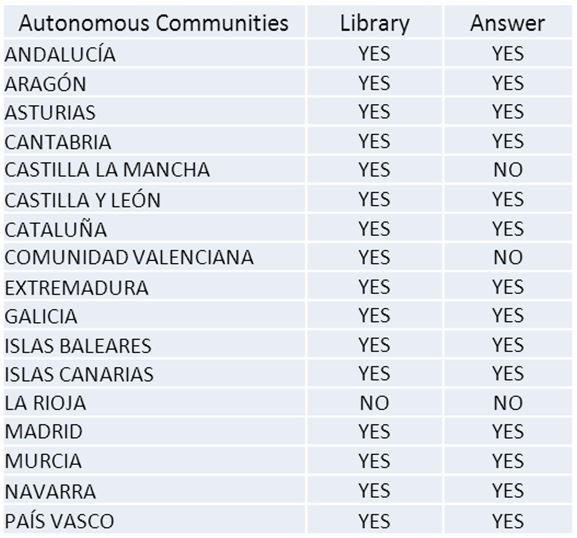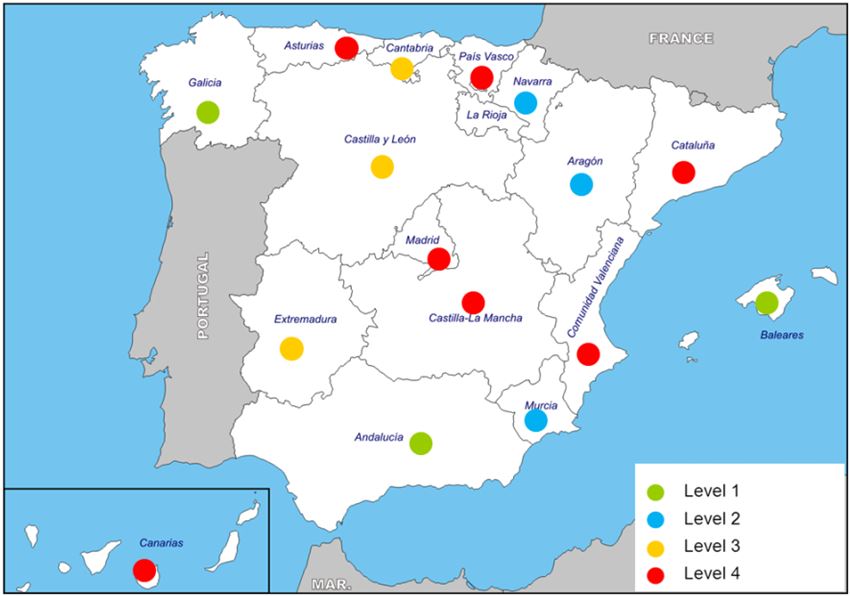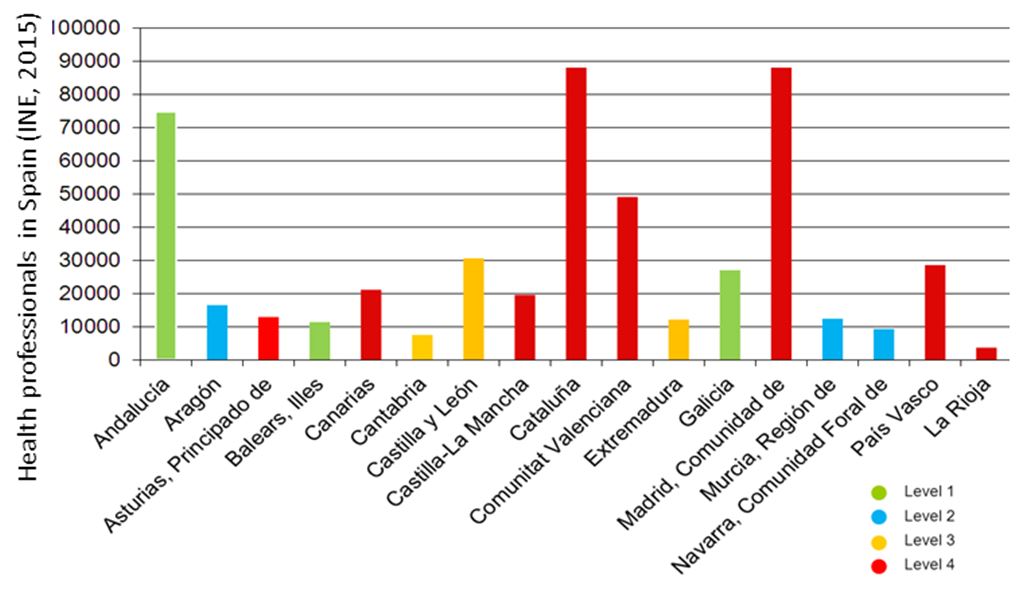Montserrat Salas-Valero1 and Jose Antonio Salvador-Olivan2
1 Aragon Health Sciences Institute. Zaragoza. Spain.
2 University of Zaragoza. Zaragoza. Spain.
Corresponding author: Montserrat Salas-Valero, msalas.iacs@aragon.es
Abstract
In line with the technological developments and the increasing access to the Internet, and after the health competences transfer, almost all Autonomous Communities (ACs) created virtual health sciences libraries which provide access to electronic resources and offer librarian services to the professionals of the health service. The creation of the virtual libraries has not followed common patters in all ACs and today, we can appreciate different organizational designs of the virtual libraries in health sciences in the ACs. However, all of them should offer a minimum of resources and services to ensure the equity in the access to relevant information needed for clinical decision making, which will has a direct impact on the quality of health care.
Key words: Medical libraries; Virtual libraries; Library administration; Library cooperation; Health information; Spain.
Introduction
Among the advantages of the Virtual Library in Health Sciences we can highlight the cost savings for public budgets as well as better service for the user. Moreover, according to the literature, access to sources of information has a significant impact on clinical decision-making and reduce the frequency and severity of medical errors (1), reduces the length of stay the patient in the hospital (2) and contributes to better patient care (3).
In Spain, after in 2002 the health competences transfer to the autonomous communities was completed, the Ministries of Health of the 17 ACs began to design regional Virtual Libraries in order to reduce spending and to provide all health professionals access to the same resources regardless of their workplace, thus democratizing access to information (4).
However, some of the problems that led to the establishment of regional libraries could not be solved (increased costs, duplication of resources). In order to improve the services, action at national level was deemed necessary, the most recent initiatives were as follows. In 2008, the Ministry of Health, Social Services and Equality (MSSSI) launched a project to study the feasibility of creating a Virtual Library at the National level. All the ACs contributed to this project. The Virtual Library of Health System of Andalusia, together with representatives from 17 other ACs, coordinated the technical aspects of the project. The findings of the project together with a proposed model were sent to the Ministry, but never implemented.
In 2013, the Health Ministry made known to those responsible for regional libraries the Uptodate subscription, and in October 2014 acquired a Discovery tool. The cost of the project was completely taken over by the Ministry of Health. In September 2015 only 3 ACs (Canary Islands, Castilla y Leon and Galicia) had implemented the Discovery Tool it in their virtual libraries, but do, at the moment, not appear at the website of the Ministry or the National Library of Health Sciences. The ministry evinced the lack of interest of this tool by the ACs. Why these two initiatives did not work?. We think that in the first case (2008) for political and budgetary reasons (Spain was plunged into a severe economic crisis), and the second (2013) in the low involvement of all regions in decision-making bodies.
The current situation in Spain, contrasts with different projects carried out in some countries with a territorial organization and a degree of health decentralisation similar to Spain. In some countries (Finland, Norway, England, USA…) there are projects which dependent on the national Ministries or on public health services, and they carry out activities through networking.
Objectives
- Mapping of the current situation of the regional Virtual Health Libraries in Spain
- Propose a model of cooperation among the regional Virtual Health Libraries
Methodology
The research was divided into two levels of study:
- A semi-structured questionnaires through telephone interviews and e-mail surveys to the managers of the Spanish regional health libraries.
- Study of usability and accessibility of their webs
In a first phase, were selected the Virtual Libraries Health Sciences in Spain.
The variables studied, following the model used by Roque Castella (5) were:
- Structure/Unit: in order to determine the institutional dependence of the library as well as the type of organization and structure of internal work.
- Funding: in order to determine the degree of institutional support economically.
- Resources/Content: in order to determine if resources are offered centrally or not.
- Processes: in order to determine if the processes are performed centrally and / or coordinated or not.
These variables are justified because they address all aspects necessary for the interpretation of the functions, objectives, procedures and working methods, as well as the identification of the services provided by each of the projects, thereby facilitating a comparative analysis.
In order to examine the characteristics of Regional Libraries, sources such as documents, reports, web pages and institutional reports were used. Email interviews have also been conducted in February 2015.
The accessibility evaluation was carried out with the TAW test (Web Accessibility Test) developed by the CTIC Foundation. The usability evaluation indicators and parameters emerged from a study published in Acimed in 2006. (6)
The ranking of the Spanish libraries has been established according to the criteria:
- Usability of the website
- Centralized purchasing process at the AC level
- Centralized services at the AC level
- Use of social media
In a second part of the investigation, we selected the 3 Spanish libraries with a high score in our ranking, in order to identify best practices among them.
Results and Discussion
The development of the Virtual Health Libraries in Spain is very different, but also the criteria used to define Virtual Health Libraries as such. The main findings of our empirical research are:

Table 1. Presence of Health Virtual Libraries in Spain on internet and answer to interviews.
All ACs interviewed (14 ACs, see table 1) are public financed and functionally dependent to the regional health ministries. A remarkable fact is that only three libraries have a consolidated budget, the rest have a budget which is established at an annual basis.
Of the 14 libraries analysed, 7 ACs have a website with an easily identifiable own URL, and 8 have their own corporative image.
The centralized subscriptions system is implemented in 6 ACs (Andalusia, Aragon, Baleares, Cantabria, Galicia and Navarra), and in the rest, 60%, there are duplicate resources (with own subscriptions in the Hospitals and with poor communication between them).
There is a very high variation in the number of journals subscribed centrally by each region: from 266 to 5300, which underlines the unequal access to scientific journals.
13 ACs use a link resolver, 1 (Andalusia) has developed a thematic repository, 2 ACs (Andalusia and Galicia) have a Discovery tool, and most the bibliographic Manager End-Note Web. Most respondents say they have centralized services, but after a review of their web pages this could not be verified.
The usability test of websites offers as result that Andalucía is getting the best ranking, followed by Galicia, Balearic Islands, Navarre, Murcia, Castilla y Leon and Aragon. The rest do not pass the test of usability, and none of the tested libraries pass the test accessibility.
With regard to social networks (twitter and facebook) in February 2015 (date of the study) had very few regional libraries with activity in these social networks.
Based on the criteria applied in this study, the existing Virtual Health Libraries could be classified according to the following levels:

Figure I: Degree of development of Regional Virtual Libraries in Spain
Level 1: accomplish all requirements: Andalusia, Galicia and the Balearic Islands
Level 2: accomplish 3 of the 4 criteria: Aragon, Navarra and Murcia.
Level 3: accomplish 2 of the 4 requirements: Cantabria, Castilla y Leon and Extremadura
Level 4: accomplish less than 2 requirements: Asturias, Canarias Islands, Castilla La Mancha, Catalonia, Valencia, Madrid and the Basque Country.
With these data, and with reference to the number of registered
physician (public and private according to the National Statistics Institute) in Spain, we can conclude that only 22% of health professionals in Spain have access to a Virtual Library Level 1.

Figure II. Number of health professionals and by colour the level of development of its Virtual Library
In the second part of the investigation, we selected the 3 Spanish libraries with a high score in our ranking, in order to identify best practices through more detailed telephone interviews: Andalusia, Galicia and Balearic Islands. The good practices identified are:
- Web design clean, clear and intuitive (Balearic Islands)
- A very active role in social networks (Andalusia, Balearic Islands)
- Centralizing subscriptions (Andalusia, Galicia, Balearic Islands)
- Coordination and/or centralization of processes: learning, Document Delivery Service … (Andalusia, Galicia, Balearic Islands)
- Model changes negotiation with publishers (Andalusia, Balearic Islands),
- Organization Information by theme (Andalusia).
Such practices have proven to be effective, which could be transferable and represent an innovative element. One of the biggest reasons is related to reducing costs, both in the acquisition of resources and the provision of services, together with greater efficiency in the coordination and involvement of dispersed personnel in hospitals.
According to the second objective, propose a model of cooperation among the regional Virtual Health Libraries, and based on the empirical evidence (7, 8, 9), we developed a draft model of a National Network of Health Sciences Libraries in Spain. With regard to the organisational aspects:
- Institutional support of the Ministry of Health (ensure their functional stability with the involvement of the Inter-Territorial Council of the National Health System
- All the ACs would be part of a collegial body created for this network called Technical Commission
- A Network secretariat in the most developed library detected in this study, Andalusia for the beginning, and then would rotate by all ACs.
- Creation of Working Groups
There are several advantages for this system: enhanced negotiating force, economic advantages, create synergy effects, balance between regions which also it implies benefits in clinical practice.
It would also be advisable to the definition and creation of Working Groups as the follow:
- Subscription resources
- Collective Catalogue
- ILL
- National Repository Health Sciences
- Collaboration generation and dissemination of Evidence Based Products
- Selective Dissemination of Information
- Patient information
- User training
- Remote access
We have also to acknowledge some limitations in research:
There are inconsistencies between what is actually in the regional libraries and the responses to the questionnaire. The 2nd objective is very ambitious, and it should take into account legal and political aspects. In addition to this, the present study should be expanded with the involvement of the only library association in health sciences in Spain, REBISALUD1.
Conclusion
The principle of equal access to the best scientific evidence is not assured in the Spanish National Health System. In order to fulfil the requirements, a library cooperation network should be established in Spain, taking advantage of the high capacities of some ACs that have highly developed projects, like Andalusia. The analysis of some national models in countries with similar degree of health decentralization showed evidence that the health ministry play usually a relevant role and have policies and strategies in Health Libraries (USA, England, Finland and Norway). In this sense the Spanish Health Ministry should be involved in this important topic for healthcare professionals in Spain.
In the analysed libraries, we found similarities in the purpose for which they were created and their main functions; however all differ in some point in relation to organization, management and quite unequal resources and services (qualitatively and quantitatively)
In this study we found evidence of significant differences in the services and resources, but all share a common goal: improving the health of citizens through access for all health professionals to better biomedical information to help them make decisions based on evidence.
The good practices identified are related to centralization of subscriptions and processes, proving to be the best tool to facilitate access to quality information resources at all levels (health care, research, training and management).
In terms of library cooperation, Spain is behind other countries with a similar level of health policies decentralization and lacks of a national strategy to avoid disparities and inequities in the access to information resources for health professionals. The librarian professionals miss the presence of an organism or library association that promotes the library collaboration. One of the main reason for collaboration is related to reduction of cost in the acquisition of resources and the provision of services, coupled with greater efficiency in their benefit under the coordination and involvement of the librarians.
Cooperation at the national level through a library network could optimize spending bibliographic and management resources, which would result in a rationalization and homogenisation of access to sources of scientific information and ultimately facilitate the achievement of the equity.
The creation of a National Network of Health Sciences Libraries in Spain is of great interest and would be justified from different points of view.
First, as already mentioned, equity in providing health services for all population groups throughout the national territory. This would imply equal access to knowledge within the health system. In recent years, it has cut the budget for libraries, however, it has increased pressure on medical professionals to maintain quality health care and make more effective and rational use of resources.
Second, healthcare professionals require high quality information based on scientific evidence, so that the resources of a library at the national level should be evaluated by qualified personnel to select those that provide quality (above quantity).
Finally, this study has tried to take a picture of the situation of regional libraries in Spain, and concludes that there is a very clear inequality in the ACs health libraries (budget, human resources, resources, library services, institutional support … ), so that the national Ministry should deal with this situation listening to the demands of those responsible for regional libraries. We, the health librarians for the virtual library in the ACs, should be able to agree on collaboration, without losing sight of the interest of a joint project and the autonomy of our regions.
References
- 1. Marshall JG. The impact of the hospital library on clinical decision making: the Rochester study. Bull Med Libr Assoc. 1992;80(2):169-78.
- 2. Klein MS, Ross FV, Adams DL, Gilbert CM. Effect of online literature searching on length of stay and patient care costs. Acad Med. 1994 Jun;69(6):489-95.
- 3. Weightman AL, Williamson J; Library & Knowledge Development Network (LKDN) Quality and Statistics Group. The value and impact of information provided through library services for patient care: a systematic review. Health Info Libr J. 2005 Mar;22(1):4-25.
- 4. Muñoz-Gonzalez L, Juan-Quilis V. Is a Virtual Library cost effective? Journal of European Association of Health Information Libraries 2011; 7: 3-6.
- 5. Roqué Castella P, Beceiro López G, Tomé MJ, Armengol G, Caro C, Catalán Vega MA et al. En busca de un modelo de red bibliotecaria: estudio comparativo de las redes de bibliotecas sanitarias y otros modelos de red. In: Bibliosalud 2011: XIV Jornadas Nacionales de Información y Documentación en Ciencias de la Salud. Cádiz; 2011, p. 77.
- 6. Robert Barrera C, Núñez Amaro S, Motola Pedroso D. Evaluación de sitios Web en Internet: propuestas para la evaluación de sitios Web de bibliotecas públicas y de salud. Acimed 2006; 14(4). [Cited June 16, 2015] Available from: http://bvs.sld.cu/revistas/aci/vol14_4_06/aci04406.htm
- 7. Canadian Health Library Association. Canadian Virtual Library: Feasibility Study and Readiness Assessment: Canada Health Infoway Phase 0 Report. 2008. [Cited May 22, 2014] Available from:: http://chla-absc.ca/nnlh/cvhl-feas.pdf
- 8. Nylenna M, Eiring Ø, Strand G, Røttingen JA. Wiring a nation: putting knowledge into action. Lancet. 2010 ;375(9719):1048-51.
- 9. Rajakiili P. The National Electronic Library in Finland, FinELib. Health Info Libr J. 2002;19(3):169-72.
________________________________
1 http://www.rebisalud.org/

